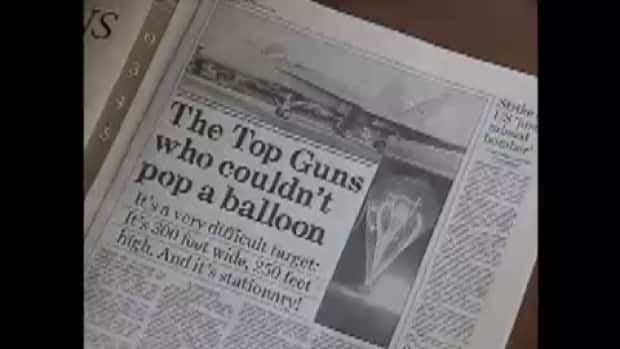The time a wayward Canadian balloon caused an international stir — and thwarted 3 air forces
China isn't the only country to face questions about a curious balloon. Back in 1998, a 25-storey high runaway weather balloon proved to be an international headache for Canada.
The helium-filled balloon — about five football fields long when deflated— was launched out of Vanscoy, Sask. on Aug. 24 with an innocent-enough task: measure ozone levels.
But according to reports at the time, the instruments on the balloon failed to detach at the end of the test.
The backup system also failed — sending the balloon aloft. Once it hit the sky's jet streams it was able to pick up speeds of 100 km/h, according to a CBC report.
Canadian CF-18 fighter jet pilots caught up with the balloon off the coast of Newfoundland and took aim, firing more than 1,000 rounds of ammunition at it.
But the balloon survived the assault, soldiering on over the North Atlantic.
A spokesperson for the air force told the Associated Press that the fighter jets were equipped with air-to-air missiles but the pilots restrained from using the heavier firepower.
"Citizens would not have appreciated having a missile blowing over their heads,″ said Maj. Roland Lavoie.
"Also, it might be overkill, spending a couple of hundred thousand dollars on a missile to shoot down a balloon that's drifting away.″
Undeterred, the balloon meandered into British airspace, forcing air traffic controllers to divert transatlantic flights and catching the attention of the British press.

"The top guns who couldn't pop a balloon," read one newspaper headline at the time, taking aim at the Canadian pilots.
But the snark was premature.
"It's a bit of a case of the pot calling kettle black," shot back Canadian Maj. Bernard Degagne on television. "In that the [Royal Air Force] also tried to bring the balloon down and were also unsuccessful."
Even the muscle of the U.S. Air Force couldn't bring the balloon to Earth, according to a BBC report.
The rogue balloon was spotted in Norweigian and Russian airspace before eventually crashing in Finland, more than a week after its chaotic journey began.
The balloon, and its more than half a million dollars worth of equipment, was later returned to the Canadian government.
While the balloon withstood a fighter jet hit, a spokesperson for the Canadian space agency said the shots fired at the balloon likely caused the craft to gradually lose altitude.
U.S. shot suspected spy balloon down Saturday
U.S. authorities had better luck shooting down a suspected Chinese spy balloon as it floated off the coast of South Carolina on Saturday.
U.S. defence officials said the balloon first entered a U.S. identification zone on Jan. 28, entered Canadian airspace three days later and then re-entered U.S. airspace on Jan. 31.
Beijing said the downing of the balloon violates international norms and it reserves the right to take further action in response.
"The U.S. in insisting on the use of force is an obvious overreaction and a serious violation of international practice," according to a statement from the Ministry of Foreign Affairs Sunday morning.
Previously, China expressed regret that an "airship" used for civilian meteorological and other scientific purposes had strayed into U.S. airspace.
WATCH | Suspected Chinese spy balloon shot down by U.S.

 Yahoo Sports
Yahoo Sports 